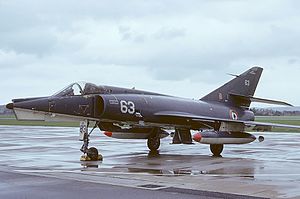BA-AS12
The BA-AS12 Wrenhawk (Fhs. Dreilseabac) is a single-engine turbojet fighter aircraft developed and produced by Fhainnin aeronautics corporation Baen Avionics.
| BA-AS12 'Wrenhawk' | |
|---|---|

| |
| Bloodhawk variant c. 1971 | |
| Role | Multirole |
| Design group | Baen Avionics |
| Built by | BA Plant Cancale |
| First flight | 8 May 1959 |
| Introduction | 1962 |
| Primary users | National Army of Faneria Asterian Defence Force |
| Produced | 1959-1963 |
| Number built | 90 |
The Wrenhawk was developed as far back as the 1940s, with the Fhainnin military attempting to maintain key spending on research and development to keep military industry on life support. In this regard, Baen Avionics was uniquely suited to weather economic downturn and a lack of substantial production contracts thanks in large part to its role as a manufacturer of civilian transport aircraft. As a result, Baen survived the 1950s relatively unscathed, and although it did not produce service-ready military jets during this period, it both launched its first line of consumer jet craft in 1956 and developed a number of prototypes as far back as the late Second Great War. The creation of the Baen Kiravia branch of the company in 1954 would lead to access to the documentation required to construct contemporary military turbojets, after which the BA-AS9 prototype was tested for functionality.

After the proof-of-function tests were performed, military planners put forward several key requirements for a mass-produced, competitive multirole fighter. The military budget of the 1960s precluded producing specialized strike and interceptor chassis, and subsequent revisions resulted in a platform which emphasized a relatively high payload and speed on a light, easily-accessible fuselage. The Wrenhawk did not stand out exceptionally in either a strike or air combat role on paper, though the single 1" cannon marked a significant drop in gunpower even compared to other cold war aircraft in exchange for a reliance on hardpoints for both air and surface attack.
The Wrenhawk was officially put into service in 1962, and represented a major upgrade in air capabilities for the Fhainnin Army from a second-rate air power back into competition with other major powers. In spite of this, the series was short-lived, with 110 units being ordered and 42 delivered before the order of a cheaper variation as the production line proved more expensive than planned. The slower and less maneuverable 'Bloodhawk', redesigned as a purely strike-oriented version, saw another 48 units finished, after which Baen would move on to a complete redesign to the far more successful BA-AS14 Skyshrike.
Design
As a lightweight fighter primarily built to carry missiles and bombs, the Wrenhawk's construction favored survivability characteristics, with a fast, maneuverable construction with a high angle of wing sweep; the original Wrenhawk is capable of transonic flight, though the Bloodhawk lacked the capability as well as an afterburner system with its simplified engine. The wings bear four hardpoints which are capable of fitting observation mounts, drop tanks, small and medium-grade bomb casings, and missiles among other specialized equipment options.
Notably, the Wrenhawk could not originally use SACLOS targeting methods due to a complicated control scheme which featured a difficult-to-view screen to link to a missile's optics; a pilot would have to physically look out the window to effectively guide such a missile to a ground target. As such, the Wrenhawk proved most functional as either an air-to-air missile platform or alternatively loaded as a tactical bomber, with infared missiles being reserved for the anti-air role due to expense through the 1960s and 1970s. Later development of self-guiding heat seeking missiles and indigenous TACAN, air sampling, and chemical analysis systems would later provide greater utility and observation capability. The engine on the original Wrenhawks was also both highly inefficient for its performance characteristics, with a fairly short maximum air time between fuelings, as well as presenting serious maintenance issues from excessive wear, defeating the advantages of making it easily accessible from most angles.
Wrenhawks were noted as being fairly difficult to pilot, leading to a number of ergonomic changes in the control layouts of future Baen fighter craft; a key influence in this decision was the loss of one of the Wrenhawks and one Bloodhawk variant in separate air incidents, both of which were narrowed down to issues with accidental toggling of controls and difficulty in reading the original instrumentation. These issues would be circumvented in the Wrenhawks themselves during conversion to a trainer role. The stress placed on learning from design issues in the Wrenhawks significantly improved later military aircraft produced by Baen, as well as providing instrumental initial experience with turbojet design and maintenance.
Service History
The Wrenhawk was solely purchased by the Fhainnin Army in their out-of-factory condition, with the original higher-power variants being retired to a training and reserve role in 1980. The Bloodhawk variants were demilitarized and sold to private air firms during the 1970s as soon as they could be replaced. Of the production run, three were preserved for museum display, two retained for the Army Air Parade Squadron, and twelve brought out of deep storage and refurbished for sale to Asteria beginning in February 2012 as trainer planes. The remainder were disassembled for parts or decommissioned after the closure of the sale.